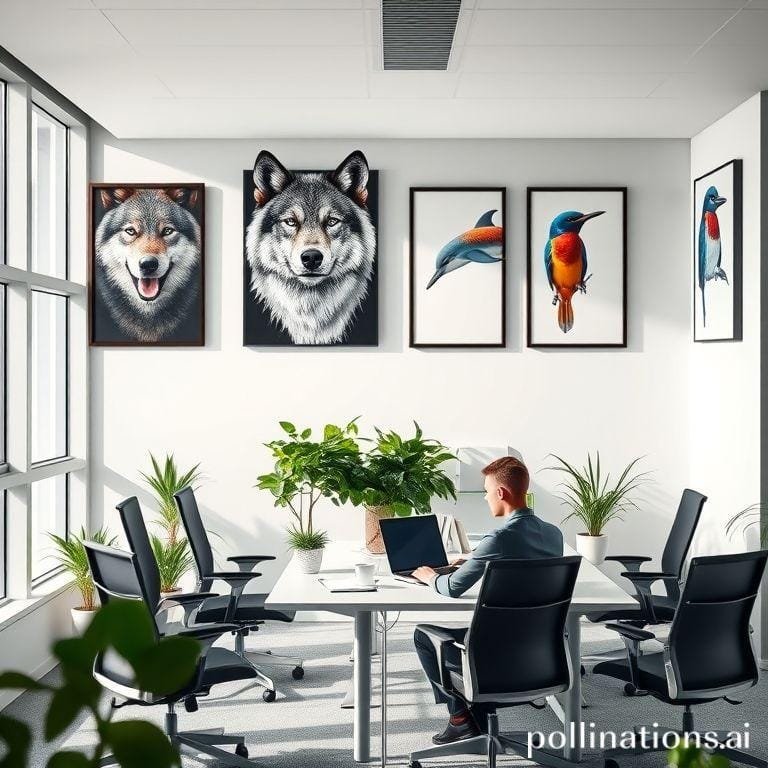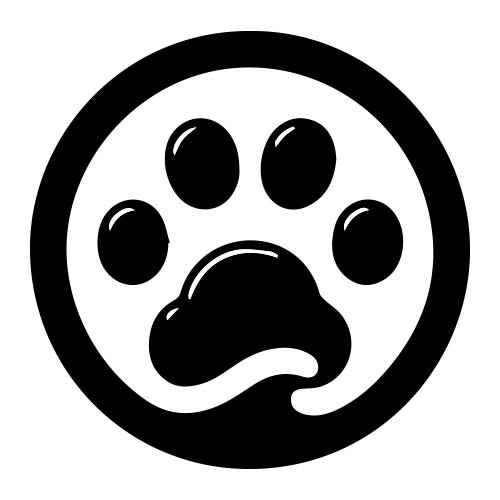Your cart is currently empty!
Boost Your Productivity with Strategic Wall Art

Think of your workspace like a garden. Just as plants need good soil and sunlight to grow, your mind needs the right environment to do its best work. The walls around you aren’t just blank spaces—they can become windows to inspiration that help you think clearer and work better.
Studies show this isn’t just a nice idea—it’s real science. Researchers found that when people work in spaces that look good, they feel better about their jobs and feel less stress. Another study discovered that letting people add personal touches like art and plants to their workspace can help them get up to 32% more work done. That’s like turning a regular workday into a super-productive one!
At Paw Creativ, we create animal-themed wall art that brings energy and good feelings to workspaces. Whether you’re setting up a company office, home workspace, or creative studio, the right artwork can change everything. This guide will show you how wall art placement affects your motivation, the science behind it, and how to pick pieces that will help you reach new levels of productivity.
How Your Brain Responds to What You See
Your brain processes what you see faster than anything else. When you walk into a room, your eyes immediately take in everything around you. Empty walls can make a space feel boring and empty, like a blank page waiting to be filled. But well-chosen artwork gives your brain something interesting to focus on, keeping your mind awake and engaged.
Dr. Craig Knight, a psychologist who has studied workspace design for over ten years, explains: “When people have control over the design of their space, they feel happier and perform better. Art isn’t just decoration—it’s a tool for psychological well-being.”
Different types of art create different feelings in your brain. Nature scenes can lower stress and help you concentrate better. Abstract art can spark creative thinking by encouraging you to see things in new ways. Art that tells stories or shows meaningful subjects can inspire you and create emotional connections. The trick is choosing the type of visual stimulation that matches the work you do.
Colors work like emotional temperature controls. Blue helps with focus and productivity—great for detailed work. Green creates calm feelings and reduces eye strain during long computer sessions. Yellow sparks creativity and positive thinking—perfect for brainstorming areas. By choosing artwork with thoughtful color choices, you can create visual signals that support different types of work throughout your day.
Animal Pictures as Motivation Boosters
There’s something special about animal images in workspaces. Animals represent qualities we want in our work lives: strength, intelligence, persistence, and playfulness. A powerful wolf picture might inspire leadership thinking, while a playful dolphin scene could encourage teamwork and creativity.
Research shows that seeing animal images can trigger happy feelings and reduce stress. This makes sense when we remember that humans have always had connections with animals. They bring a piece of the natural world into office environments, creating balance and harmony in man-made spaces.
At Paw Creativ, we’ve created collections that use these psychological benefits. Our wildlife photography shows animals in their natural homes, creating a connection to nature that reduces mental tiredness. Our abstract animal art uses creative representations that spark imagination while keeping that connection to living creatures. Each piece is designed not just to look good, but to serve a specific purpose in your workspace.
Where you place animal-themed art matters too. Predator images (lions, eagles, wolves) work well in leadership offices or competitive spaces where strength and strategy matter. Community animals (dolphins, elephants, primates) are perfect for team areas. Solitary but graceful animals (snow leopards, owls) can inspire focused, independent work. By matching the animal’s symbolic qualities to your work, you create subtle but powerful motivational signals.
Lowering Stress and Mental Tiredness
Modern workplaces are full of stress: deadlines, meetings, constant notifications, and performance pressure. Over time, this constant stress leads to mental fatigue, trouble concentrating, and eventually burnout. Strategic wall art can help balance these pressures.
Studies using body measurements show that viewing nature scenes—even in photographs—can lower blood pressure, reduce stress hormones, and slow heart rate. This physical response creates a calmer mental state that helps with focus and problem-solving. Art provides visual “rest areas” for your eyes and mind, offering breaks from screen-based work.
The idea of “visual resting points” is especially important in open offices where constant movement and activity can be overwhelming. Well-placed artwork gives your eyes a place to focus that isn’t a screen or another person, providing mini-breaks that refresh your mental energy throughout the day.
We recommend creating “visual sanctuaries”—small areas where employees can briefly rest their eyes on calming images. This might be a nature scene above a water cooler, an abstract piece near a window, or animal photography in break areas. These intentional visual elements create psychological safety valves that prevent stress from building up too much.
Boosting Creativity and New Ideas
Creative thinking requires your brain to make new connections between different ideas. Art, especially abstract and unusual pieces, provides the visual stimulation that encourages this kind of flexible thinking. When we look at art that doesn’t have an obvious meaning, our brains work to understand it, engaging the parts associated with imagination and insight.
A study found that employees in art-filled environments came up with 15% more ideas during brainstorming compared to those in bare offices. Researchers concluded that art acts like a “thinking spark” that prompts the brain to think beyond usual patterns and solutions.
Animal-themed art works particularly well for stimulating creativity because animals themselves show adaptation and innovation in nature. The way a chameleon changes color, a spider builds its web, or a bird makes its nest—these are all examples of creative problem-solving that can inspire human innovation.
For creative teams and innovation departments, we suggest creating “idea walls” with multiple art pieces that represent different aspects of the creative process. This might include pieces showing animals in motion (representing action), detailed patterns (representing careful thinking), and wide landscapes (representing big-picture vision). By surrounding teams with these visual metaphors, you create an environment that constantly supports creative thinking patterns.
Personal Touches and Emotional Connections
One of the most overlooked parts of workplace design is personal connection. When employees feel their workspace reflects who they are and what they value, they care more about their work. Art provides one of the best ways to create this personal connection while keeping a professional look.
Research shows that employees who have some control over their workspace design report 30% higher engagement levels. This doesn’t mean allowing messy or inappropriate personal items, but rather providing opportunities for meaningful personal expression through careful art choices.
Animal themes offer a great middle ground for personalization. Most people have positive feelings about certain animals—whether it’s a childhood favorite, a cultural symbol, or simply a creature they find beautiful or inspiring. By letting employees choose animal art that means something to them personally, companies can create individual spaces that still maintain a unified overall look.
We’ve helped many companies implement art personalization programs that balance individual expression with brand consistency. The key is providing a selected group of appropriate pieces—enough variety for personal choice, but within limits that ensure professional appropriateness. This approach respects individual differences while keeping a consistent visual language throughout the organization.
Putting It Into Practice
Knowing that art improves productivity is one thing; using it effectively is another. The wrong art, poorly placed, can become a distraction instead of a help. Here are practical strategies for getting the most productivity benefits from workplace art.
First, think about sight lines and viewing angles. Art should be placed where it will be seen during natural work breaks—when looking up from the computer, during conversations, or when moving through spaces. The best height is at eye level when sitting or standing, depending on how the space is mainly used.
Second, consider size and proportion. A small piece on a large wall can feel unimportant, while an oversized piece in a small room can feel overwhelming. Generally, art should cover about 60-75% of the available wall space for the best visual impact without feeling too crowded.
Lighting matters greatly. Art should be properly lit to be appreciated without creating glare or reflection problems. Natural light is best, but directed artificial lighting can work well too. Avoid placing art directly opposite windows where sunlight might cause fading over time.
Finally, consider “art rotation.” Just as our brains get used to constant stimuli, artwork’s impact can fade over time as we become familiar with it. Changing pieces periodically—maybe seasonally or every few months—refreshes the visual environment and maintains the thinking benefits. This doesn’t require buying new art constantly; simply moving existing pieces to different locations can provide enough newness to keep the positive effects.
Changing your workspace with strategic wall art isn’t just about looks—it’s an investment in productivity, creativity, and well-being. The research is clear: environments matter, and art is one of the most powerful tools we have for intentionally shaping those environments. From reducing stress to boosting creativity to building personal connections, the right artwork can turn ordinary workspaces into extraordinary places where people do their best work.
We’ve seen how animal-themed art can transform offices, home workspaces, and creative studios. Our collections are designed specifically with these psychological benefits in mind, combining beautiful images with intentional design principles. Whether you want to create a calm space for focused work, an inspiring environment for creative thinking, or a personalized area that reflects your team’s unique identity, we have pieces that will meet your needs while helping your productivity reach new levels.
The connection between environment and performance is too important to ignore. In a world where companies spend millions on ergonomic chairs, standing desks, and the latest technology, it’s surprising how many overlook the powerful impact of what’s on the walls. Yet this might be one of the most cost-effective investments you can make in your team’s productivity and satisfaction. Start small if you need to—even one well-chosen piece can make a noticeable difference. Then build from there as you experience the benefits yourself. Your walls are ready to become your greatest productivity tool.
